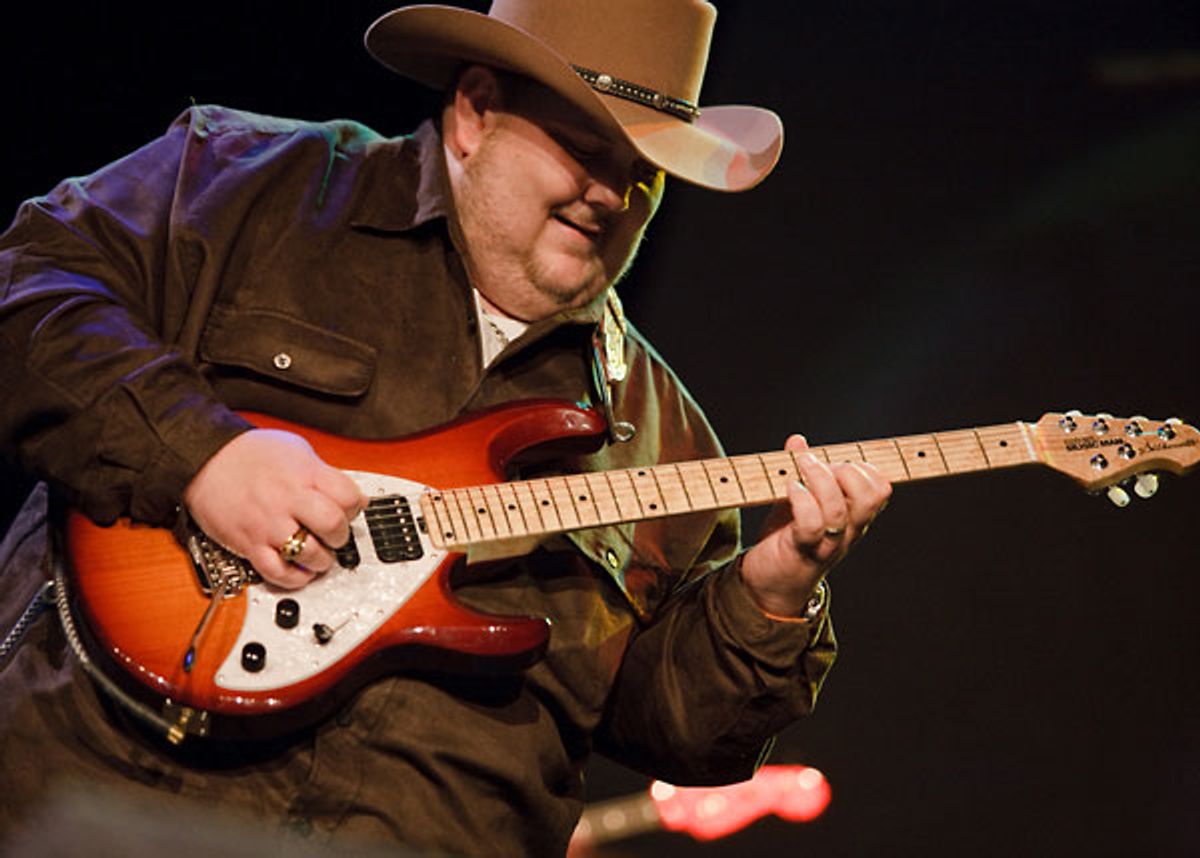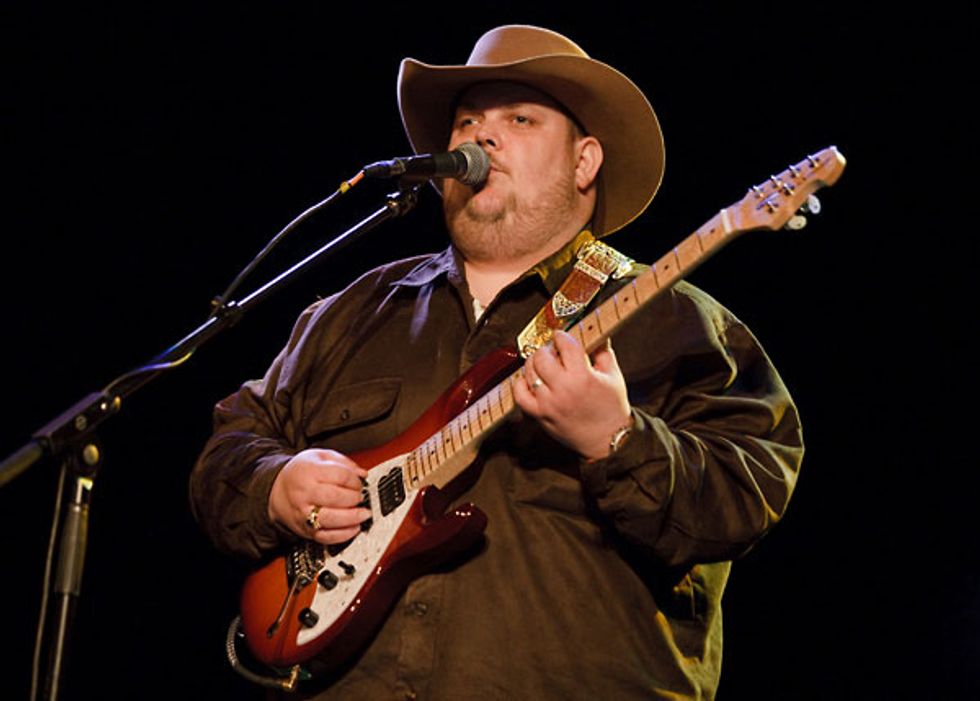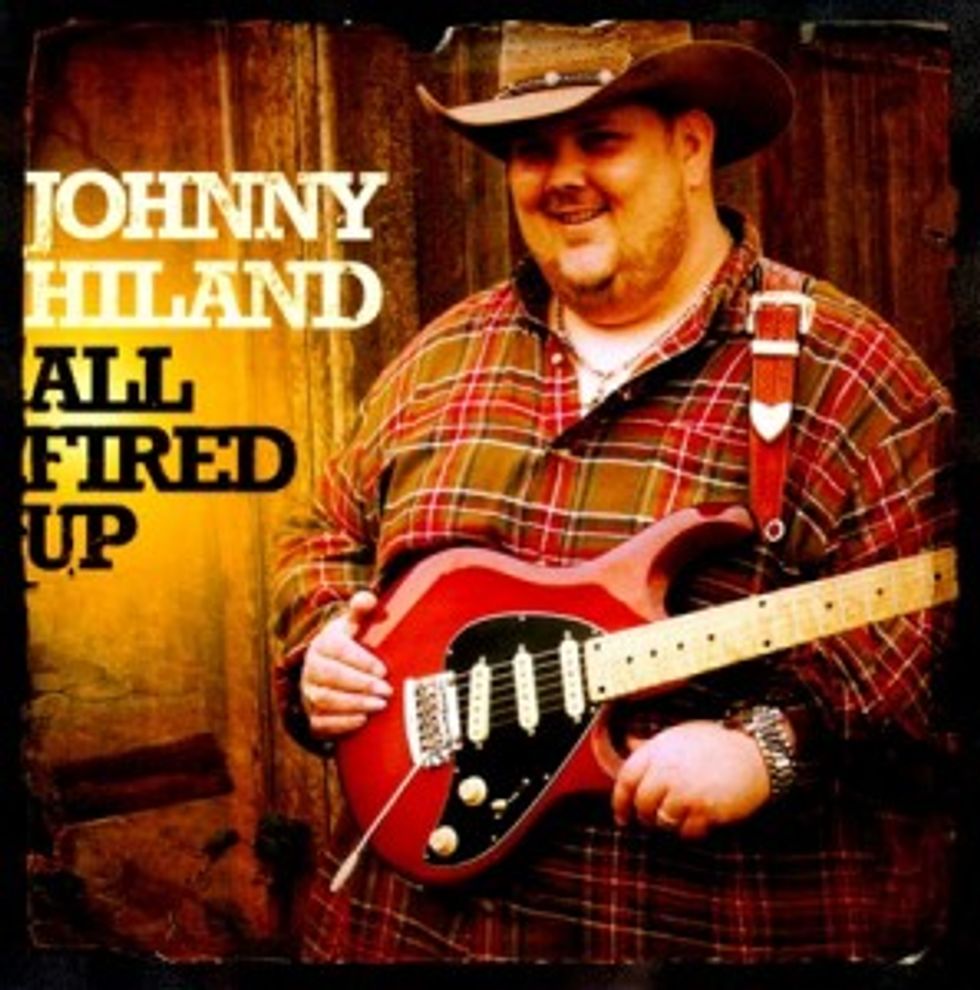
Johnny Highland talks about early influences, his emotional connection to the guitar, and bringing chicken pickin’ to the masses with his latest album, "All Fired Up."
Music isn't just an obsession for Johnny Hiland. It's been woven through every part of his life since he was a child in Bangor, Maine. “I was a very, very, very young boy—a 2 1/2-year-old—when my Aunt Brenda came over to give my father their father's 1939 J45 Gibson. It had been in her attic for a number of years and looked like something that had come over on the Mayflower. It was all beat-up, but it had all the tuning keys and was still a fully functional guitar. I just gravitated to it and it grabbed hold of me, kind of like Linus with the security blanket. I had to be with that guitar all the time.”
Hiland's licks may be lightning-fast and accurate as clockwork, but because of his life-long love of the guitar, there's an emotional component to his playing that makes him far more than just a superb technician. “Chicken pickin' is fun music. If you go out there in a bad mood, you're gonna have a smile on before you’re done, 'cuz it'll do that to you whether you want it to or not. It's such an invigorating style to play—that's why I love chicken pickin'. It’s complicated and not an easy genre to play, but I just go out there and try to be myself, allowing the music to reach out there as best I can. Hopefully it’ll brighten somebody’s day.”
His new record for Shrapnel, All Fired Up, contains all the fun, love, and excitement that Hiland can muster, and his fans know that's considerable. “I call it ‘chicken pickin' on steroids’ because I really think we created a new kind of chicken pickin' and a whole different sound that even Nashville's not used to,” he explains. With a killer rhythm-section comprised of Steve Vai’s bassist, Stuart “Stu” Hamm, and Jeremy Colson on drums, he's crafted a chicken pickin' smorgasbord that crosses from country to rock to R&B—and even brushes up against jazz.
All Fired Up was produced by Mike Varney, who provided Hiland the opportunity to make the record he always wanted to make. “I think you can stretch as a guitar player and reach out to a lot of different styles, but there is one main element or genre where you cut your teeth that everybody loves to hear you play. I just had to find it in myself to say, OK, I'm a chicken picker, but it's okay for me to stick some other styles in there—just not making them the dominant thing. So when I did this album with Mike, it was a chance for me to do just that.”
School Bus Rock
Hiland's relationship with the guitar as a youngster was not exactly typical. “By 4-years-old, I would stay on the school bus with the guy who drove it. He ran a small Italian restaurant in our town and I would sing Willie Nelson songs to him on the bus. I often forget to get off at my stop, so he would finish his route and take me back to his restaurant where he'd call my mom and say, 'I'm feeding the boy spaghetti and he's playing for his dinner.'”
Hiland’s father, a drummer, didn't know standard tuning for the guitar at the time, so he tuned it to an open-E, which was how Hiland played for several years. “I kinda played like Jeff Healey with the guitar flat on my lap, and I used my thumb to walk the bass line. It was an interesting way to play, but what it really did was develop my right hand. I learned to strum well at an early age and I played that way until I was 10-years-old.” As a 7-year-old, he appeared on television for the first time, and then went on to win the Talent America contest at the age of 10. It was then he began learning his first chords in standard tuning. “I started a small folkie/bluegrass career, and it was a fun for me. Since I wasn't able to play kickball, baseball, or basketball like the other kids in school—and of course was made fun of—I would take out my emotions on the guitar. It really became my emotional outlet and it remains so to this day.”
Growing up, his musical addiction was country music. “I wanted to be Roy Clark when I was a little boy. I loved Roy Clark, Buck Owens, and the whole Hee Haw gang. I'd also stay up at night with my dad and watch Austin City Limits.” Being visually impaired, sound moved Hiland in deeper ways. “When I hear a piece, I just try to wrap myself in it. For me, it's how sonic waves and sound move— I love hearing orchestras and horn sections. It really can engulf you.”
But it was the guitar that spoke clearest and loudest to Hiland, even as a child. “There's a passion that lives inside of us, and when a form of music grabs ahold, it'll throw you around a little bit and make your soul jump. That's what I always tried to do when I played guitar, even as a little kid. I loved the sonic values of every guitar string and what they were capable of doing. To to this day, I still find it so intriguing.”

Telecaster Dreams
Ricky Skaggs provided the inspiration for Hiland to pick up a Telecaster. “I was a big Ricky Skaggs fan as a kid. I saw him on TV one day and I said, 'Dad, I wanna go see him live.' When I was 10-years-old, my dad found out he was playing at the Bangor Auditorium and I remember him saying to me, 'Kid, I can't believe I'm wasting the money to see Ricky Skaggs 'cuz he'll never sound as good as he does on a record!’” Hiland laughs as he recalls that seeing Skaggs jumping up on top of a PA speaker with his Telecaster initially provided the spark. “From then on, I was a changed kid. I loved the acoustic guitar and I loved the bluegrass thing, but there was something about the electric guitar that had a bigger sound. I tried everything I could to push more volume, more tone, more everything. I don’t think my mom and dad knew what they were getting themselves into with all the pedals, effects, and all that good stuff.”
The Skaggs influence may be the root of Hiland's style today. “Nobody in Maine knew what a B-bender was. I was so hooked on Ricky's sound—and not realizing that he used a B-bender—I basically learned all the Ricky Skaggs, Marty Stewart, and Jimmy Olander licks without one. I think with repetition, one can slowly develop such preciseness over time. After playing that style for twenty years, I finally feel like I'm comfortable in doing that. I love the whole chicken pickin'-style, and after being turned on to Ricky, I learned about Albert Lee and Danny Gatton.”
Fun in the Studio
 “Of all the records I've done so far, this album means the most to me. It really allowed me to find where I'm the most comfortable,” says Hiland of All Fired Up. “I wanted to take chicken-pickin' guitar to the rock market and show rockers that chicken pickin' is cool and a very adept, complex style. I wanted to show that it’s not as easy and hillbilly as some people think it is.”
“Of all the records I've done so far, this album means the most to me. It really allowed me to find where I'm the most comfortable,” says Hiland of All Fired Up. “I wanted to take chicken-pickin' guitar to the rock market and show rockers that chicken pickin' is cool and a very adept, complex style. I wanted to show that it’s not as easy and hillbilly as some people think it is.”
Luckily, Hiland and Varney hit it off right away, and the whirlwind recording project was almost immediately set in motion. “I talked to Mike for the first time in December 2010, and by February, I was out in California cuttin'—so it was a massive frenzy of writing for me. I wasn’t necessarily in panic mode, but I was real busy.” Hiland had wanted to work with Stu Hamm for a long time, so the prospect of working with him was thrilling. And Varney made the suggestion of getting Jeremy Colson on drums since Hiland's goal was to take chicken pickin' to a rock market. “I first met Jeremy through playing with Steve Vai. I thought, man, this is going to be a cool and different thing—not something typical that Nashville is used to hearing. I also thought it would be really interesting to see how these boys pull off the chicken pickin' stuff.” The experience more than lived up to his hopes. “I had some of the best times of my life playing with Stu and Jeremy. There's no fear with Jeremy. In 'Barnyard Breakdown' I said, 'Man, can you do a double-kick train beat?' He just started messin' with it for a minute, and next thing you know, he's got it.”
Varney approached the recording a little differently than what Hiland was expecting. “We started with two days of rehearsal, and I'm thinking, 'Rehearsal? Who rehearses for a record?' I thought, man, you get in here with Stu and Jeremy, hit the record button, and away you go! But I'm so glad because it was really an awesome way of doing a record. I got into a room with the guys, and we spent two full days making sure my charts were correct, the song was structured the way it should be, and that it was the length it should be.”
The approach greatly accelerated and simplified the entire process. “We tracked the rhythm section the first day we went in. I loved it because it really helped eliminate the whole pre-production thing. I've done it the other way in the past by going into the studio, recording all these songs, and trying to get them right. It wears you out as an artist when you go and cut the whole album as demos, and then have to go back and restructure things and make changes. When you go to cut the final record, you're already kind of sick of the songs. I think our approach is what really brought about the freshness of this album.”
Toys, Tools, and the Essential Stuff
Hiland began playing Ernie Ball Music Man guitars in 2010, and has recently been using a Silhouette model—the only guitar Hiland used on the lead-guitar tracks for All Fired Up. “I find it to be the most comfortable-playing guitar I've ever owned. Recently, a gentleman named David Allen created some new Johnny Hiland signature pickups that are similar to Bardens, but have a really unique country-tone. They’re dual-blade pickups, yet they offer a range from Tele-style to Strat-style tones, so my guitar is a bit different than a standard Silhouette. But, it's cool because people can buy Johnny Hiland pickups from David and transform their guitar into exactly the same guitar I'm using.” Highland has also been endorsing Godin Guitars for the last year and a half and played rhythm on the record with an Acousticaster and a Multiac. “The Multiac is the first nylon-string guitar I've ever owned and that guitar has just captured me. I'm in love with the thing,” says Highland.
"Nowadays I'm not concerned with how fast can I play, I'm always concerned with how clean I can play. What am I saying when I play? Are my notes reaching people souls?"
Hiland had far more difficulty finding an amp to match his goals for the album. “The amplifier thing was just stumping me. The boutique world has kind of been the main thing going on and players have been going to very low-wattage amps, but I'm just the opposite. I like a 100-watt amp or higher because the more power you have, the cleaner your tone will stay.” While attending the 2011 NAMM show in January, Hiland ran into a company called XP Audio and tried their new amp line called the Bolt. “They had this 2x12 combo with three channels, and the clean tone was literally the best, chicken-pickin' tone I've ever heard—and I'm talking just guitar going straight in. The amp is just mesmerizing and I actually had two 2x12 Bolt combos at the studio for the album."
For effects, Hiland uses a Johnny Hiland Kilo-Wah, a Boss TU-3 tuner, a Wampler Ego Compressor, and a Brad Jetter Red Shift and Voodoo Lab Sparkle Drive Mod for distortion. “My main pedal that I can't live without is the ISP Decimator, 'cuz it takes all your excess noise out from your complete sound. With my ears being so sensitive, I rely on that pedal a lot.” He also has a Boss tremolo and a Hardwire delay from Digitech in his setup, all housed on his Pedaltrain 2 with a Voodoo Lab power-supply. “It's a pretty simple little rig, but it's powerful and will get the job done.”
Everything Comes Together
“I'm 36-years-old now, and I remember being a youngster and hearing people say, 'Wow, I can't wait to hear that guy when he's 40.' And now I look back and understand what people meant by that, because nowadays I'm not concerned with how fast can I play, I'm always concerned with how clean I can play. What am I saying when I play? Are my notes reaching people souls? Am I making a melody that's gonna stick with you? I'm trying to write songs that mean more, rather than just songs that are technical.” Hiland's early work with Vai has paid off in unexpected ways. “I have to thank Mr. Steve Vai because he was so hard on me with the first album [released on Vai's label] when it came to writing material. He always kept driving home 'less noodling, more melody!' What Steve really did for me was teaching me how to craft a song. I feel I was more comfortable in my writing and more comfortable with what I really wanted to convey to my audience with this album. I really am proud of this record, and I sincerely hope that people go out and get it. If people have been waiting for the right Johnny Hiland record, to me, this is the best I have to offer.”
Johnny Hiland’s Gearbox
Guitars
Ernie Ball Music Man Silhouette
Godin Acousticaster
Godin Multiac
Amps
Bolt BTC-100
Pickups
D. Allen JohnnyBlades single-coils
D. Allen JohnnyBuckers humbuckers
Effects
Wampler Ego Compressor
Boss TU-3
Brad Jetter Red Shift
Voodoo Lab Sparkle Drive Mod
ISP Decimator
Boss tremolo
Digitech Hardwire delay
Pedaltrain 2 pedalboard
Voodoo Lab power supply
Gig-fx Johnny Hiland Kilo-Wah
